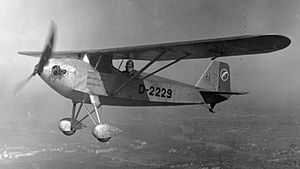Akaflieg Berlin AB4
| Akaflieg Berlin AB4 | |
|---|---|
 Akaflieg Berlin AB4 via Berlin-Johannisthal |
|
| Type: | Light aircraft |
| Design country: | |
| Manufacturer: | |
| First flight: |
December 1931 |
| Number of pieces: |
1 |
The AB4 FF was a single-seat light aircraft of the Academic Aviation Group of the Technical University of Berlin with the aircraft registration D-2229.
history
The aircraft was created in response to a tender for a light aircraft by the German Aviation Association (DLV). Built in the Akaflieg workshop on the premises of the German Aviation Research Institute (DVL), the first flight took place in December of the same year at the Berlin-Johannisthal airfield . The AB4 emerged as the winner of the competition and was presented at the German Air Sports Exhibition (DELA) in Berlin in October 1932 in order to stimulate inexpensive powered flight in Germany. As a result of the economic crisis , these efforts were unsuccessful, so that no more copies were built. After the aircraft had flown in the club until November 1933, it had to be handed over to the restructured DLV together with the other powered aircraft.
construction
The aircraft was designed by Martin Schrenk , Walter Stender and Gerald Klein according to the DVL regulations for aircraft with limited aerobatic capabilities. The aspirated high-decker with fabric-covered wings and a hexagonal fuselage that can be folded by one person for road transport is designed for a breaking load multiple of 8 g . The chassis consists of a sprung two-wheeled chassis at the front and a grinding spur.
In order to decouple the vibrations of the restlessly running Daimler engine from the fuselage structure, the engine block was articulated. The simple construction of the fuselage and wing made of wood in standard sizes - essentially 6 mm thick pine lamellas and 1 mm plywood panels - should encourage a replica in clubs . The production of complex parts such as the handlebar fittings was planned in series in specialized workshops.
Numerous openings make the aircraft easy to maintain. So you can get behind the folding pilot's seat in the fuselage almost to the tail unit. Aircraft control installations such as pulleys can even be seen in flight.
Technical specifications
| Parameter | Data |
|---|---|
| crew | 1 |
| length | 5.70 m |
| span | 9.00 m |
| height | 2.40 m |
| Wing area | 10.0 m² |
| Wing extension | 8.1 |
| payload | 100 kg |
| Empty mass | 185 kg |
| Flight mass | 285 kg |
| Landing speed | 60 km / h |
| Top speed | 125 km / h |
| Service ceiling | 3500 m |
| Range | |
| Engines | 1 × Daimler F 7502a , 14.7 kW (20 PS) |
Comparable types
- Hermann Mayer MM 1
See also
Individual evidence
- ^ Hans Joachim Wefeld : 75 years of Akaflieg Berlin . Academic Fliegergruppe, Berlin 1995, DNB 949054607 , p. 35 .
- ↑ a b Hans Joachim Wefeld: 75 years of Akaflieg Berlin . Academic Fliegergruppe, Berlin 1995, DNB 949054607 , p. 38 .
- ^ Walter Stender: "FF" small aircraft from Akaflieg Berlin . In: Aviation . No. April 8 , 1932, p. 149-151 .
